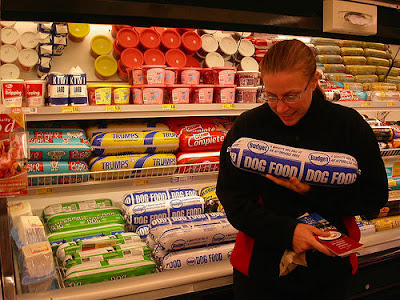How to Read a Pet Food Label
Unknown | 9:42 AM |
Dog Life
,
How To Pet
Finding the best food is vital to your pet's health and longevity. But deciphering pet food labels can be confusing. Follow these steps to be able to understand pet food labels and be able to compare pet products with confidence.
Learn to look beyond the marketing claims accompanying pet food.
In the USA, pet food labeling is regulated on a federal (FDA) and state-by-state basis, with guidance from the Association of American Feed Control Officials (AAFCO). However, AAFCO provides only minimum requirements.
The reality is that pet food producers often use terms that are undefined by the regulations, in order to communicate more effectively with consumers and improve their product's image in the market. The AAFCO warns on their website that "it is not rare at all that labeling and marketing information is designed to appeal to the latest trend in marketing human products." In other words, the focus tends to be more on appealing to our preferences than on whether or not the food is suitable for your pet.
For this reason, learn to look behind the marketing hype and to find the real substance of the nutrition status within the pet food.
Locate the "Guaranteed Analysis" on the pet food label.
See the example under "Tips" below. Note that the percentages given for protein, fat, and fiber are measurements of the food in its current state. However, because different pet foods have different levels of moisture, you can only logically compare pet foods on a dry matter basis. Moisture levels in pet foods can range from approximately 6 percent to as much as 80 percent. Canned food obviously contains more moisture than dry kibble. But it may not necessarily contain as much protein, for example. You can't tell which food contains the most protein, fat or fiber until you have converted both labels to a dry matter basis.
Determine the amount of dry matter first, by subtracting the percentage given for moisture from 100 percent. Using the example below, the moisture accounts for 10 percent of the pet food. Therefore, the dry matter content is (100% - 10% = ) 90% of the pet food.
Convert the protein, fat and fiber percentages to a dry matter basis by dividing the percentages given on the label by the amount of dry matter (from the previous step). In our example, the 26 percent protein on the label converts to 28 percent on a dry matter basis by dividing 26% by 90%. (Notice that in this example the dry matter calculation is only slightly different than the labeled percentage. This is because the moisture level was only 10 percent per the label. If the moisture level had been, say, 40 percent, then the dry matter content would have only been 60 percent and protein on a dry matter basis would have been calculated as (26% divided by 60% =) 43%.)
Compare the new protein level of 28 percent on a dry matter basis to other pet foods (once you've converted the other pet food labels in the same way). Do similar comparisons for fat and fiber after converting to a dry matter basis calculation.
Be aware that percentages alone don't tell the whole story.
You may have 28 percent protein on a dry matter basis, but what is the source of that protein? You can get protein from chicken beaks and feet that are not good sources of nutrition for your pet! This means that you'll need to look next at the list of ingredients. Pet foods must list ingredients in order of weight. Generally, the first five ingredients will make up the majority of the pet food product. Ideally, look for meat as one of the first ingredients on a pet food label. Grains, such as corn, corn meal, whole wheat, barley, rice are used to provide essential energy for the pet and appealing texture to the kibble.
Even the AAFCO website admits that "Economics plays a part in any ingredient selection" and "protein is not simply protein. Ingredients providing protein have specific amino acids which may or may not match the amino acid profile required by a cat or a dog." Manufacturers routinely combine multiple protein sources to provide for all the amino acids required for a healthy life.
Be mindful that pet food manufacturers can manipulate this information.
For example, by breaking an ingredient down into components and then listing them individually so that you don't notice a easily recognized undesirable ingredient too near the top of the list, this information can be effectively changed enough to cause you to read the label differently.
Some pet owners search for pet foods that use human grade ingredients with no animal by-products and avoid pet foods that use artifical colors, flavors, sugars and chemical preservatives (notably BHA and BHT).
However, some animal by-products like liver and other internal organs are excellent sources of the amino acids and other nutrients that dogs and cats need. In addition, dry pet foods need preservatives to prevent spoilage and degradation of essential nutrients.
Contact the manufacturer direct to find out what the "by-products" listed in their product actually consist of. Be aware that this may change without warning. Sometimes your pet's reaction will be enough to make this obvious!
Do a cost per weight analysis to determine the weight value of the pet food product.
The density of dry products can be changed through puffing up the food, while different wet foods can be labeled with pounds or ounces (or other measurements), making weight comparison harder. Check the price comparison to get the real value.
Check the label for "nutritional adequacy".
This is one of the most important aspects of a pet food label because it can impact a pet's health if claims are made about being nutritionally complete when the product is not able to meet all nutrient requirements for your pet. To be reassured on this count, look for:
The words: "(Name of product) is formulated to meet the nutritional levels established by the AAFCO (Dog/Cat) Food Nutrient Profiles."
Or look for the words: "Animal feeding tests using AAFCO procedures substantiate that (name of product) provides complete and balanced nutrition."
Be sure to choose the right life cycle stage for your pet - this should be on the label too (for example, kitten/puppy). Pet food needed for pets that are growing, reproducing or working hard should be chosen with care that it can meet all the nutrient requirements for that pet. Size, breed or senior labeling claims must meet the criteria for adequate adult pet nutritional needs; in reality, the more precise claims are harder to ascertain.
Read the feeding instructions.
Even if you think you know how to feed your pet the particular product, changes do happen or you might have transposed feeding instructions from one product to a new one. Always read these with care to ensure that you are feeding your pet adequately. However, even though manufacturers try to cover all contingencies, you still need to monitor your own pet's needs, preferences and environmental conditions. Talk to your vet if you're unsure, especially with respect to growing and reproducing pets.
As part of feeding, also read the calories provided by the product. The amount of calories provided can vary considerably between products and between dry and wet foods. If your pet is growing, overweight or underweight, or has an illness, calories are of especial interest.
Calorie statements are made on a "kilocalories per kilogram" basis. Kilocalories are the same as the "Calories", while a "kilogram" is a unit of metric measurement equal to 2.2 pounds. It may also be stated as "per cup" or "per can", alongside the required kilocalories per kilogram statement.
Be savvy about marketing claims such as natural, organic, premium, etc.
These are marketing words without official definitions to back them up. While it is surely to be hoped that all pet food is "natural", this usually refers to a lack of artificial additives, colors or flavors. The words "premium" and "gourmet" and the like are marketing speak and don't mean anything more than what the overall packaging suggests to the consumer. Organic pet food should be free of synthetic additives but guidelines are still under development for the official meanings.
Here's an example of the guaranteed analysis section of a pet food label:
GUARANTEED ANALYSIS:
Crude Protein, not less than……….….26.0%
Crude Fat, not less than……………....16.0%
Crude Fiber, not more than…...............4.0%
Moisture, not more than……………….10.0%
Be aware that actual meat may not have to be added to a pet food to produce a "flavor". For example, a chicken flavor can be produced using a "chicken digest" (such as heat treatment or the addition of enzymes or acids), while a real chicken hasn't been anywhere near the resulting product. Also be aware that claims of "no artificial flavors" are often marketing hype as few pet foods include such flavoring.
Do not feed cat food to dogs and vice versa. Each species has different nutritional requirements, which the pet food manufacturers cater for.
Source: wikihow.com










0 comments:
Post a Comment